Electric drive and power domain research: efficient integration becomes a megatrend, and integration with other domains makes power domain stronger.
Electric drive systems have gone through several development phases from independent module, integration of motor and transmission, and partial integration of ECU, motor and transmission, to three-in-one and X-in-one integration. In the trend towards "software defined vehicles", E/E architectures tend to be domain controller centralized and centralized ones. Electric drive systems evolve from conventional "three-in-one integration" at the mechanical level to "X-in-one integration" at the power electronics + "software integration" at the power domain level. Continuous deep FOTA updates favor the better performance of vehicle power systems.
OEMs: accelerate mass production of efficient and intelligent electric drive system solutions.
When selecting electric drive solutions, OEMs will consider five factors - power density, integration level, efficiency, safety and intelligence. These factors are of primary importance whether OEMs choose to self-develop or buy from other components manufacturers. In the next stage, new technologies such as X-in-one integrated electric drive, 800V voltage platform, SiC/GaN power devices and power domain will give a big boost to the electric drive system industry.
BYD's “eight-in-one” electric powertrain: in 2021, BYD introduced an eight-in-one electric powertrain based on e3.0 platform. The high integration of motor, transmission, motor controller, PDU, DC-DC, OBC, VCU and BMS further decreases the space usage and weight of the system. Compared with the previous generation, the solution features 20% higher power density, 15% lighter weight, 20% smaller size, and overall efficiency up to 89%.
As an automaker, BYD builds 400V medium-voltage and 800V high-voltage vehicles on the same platform. The independent boost device and reusable drive system power devices constitute a boost charging topology that enables modular boost architecture. The high-voltage platform adopts 1200V/840A SiC power modules that enable 60% smaller size, 70% lower switching loss, and electric control system efficiency up to 99.7%, relative to IGBT controllers.
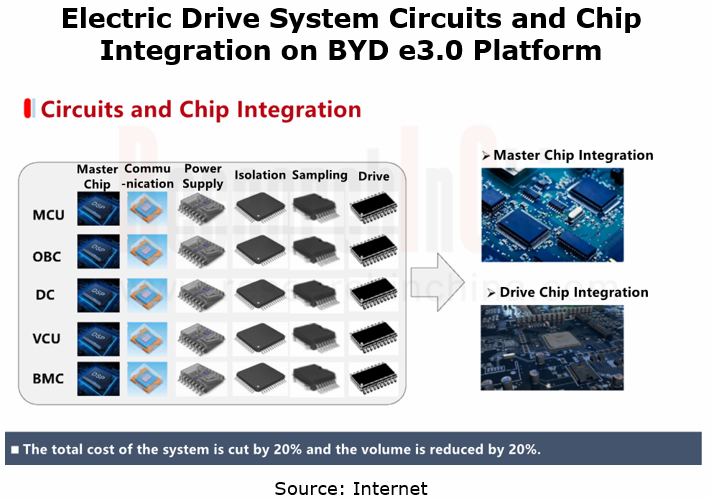
NIO's second-generation electric drive system: NIO has established the route of front permanent magnet synchronous motor and rear induction asynchronous motor. The maximum power of the permanent magnet synchronous motor and the induction asynchronous motor reaches 180KW and 300KW, respectively. NIO chooses ON Semiconductor's latest VE-Trac? Direct SiC power modules for the front permanent magnet synchronous motor of its second-generation electric drive system.
NIO's electric drive systems are provided by its subsidiary Shanghai XPT Technology Limited. XPT has made a one-line, multi-site manufacturing layout in Nanjing, Shanghai and Hefei.
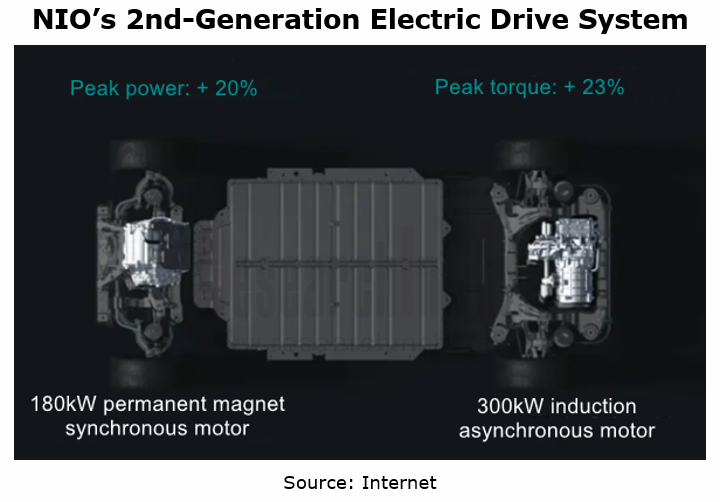
Components manufacturers: deploy new electric drive system products and expedite technological iteration.
As "three-in-one" integrated electric drive systems mature, the next step will be to achieve "X-in-one integration" at the power electronics level, that is, deep integration of on-board charger (OBC), high-voltage DC/DC converter, inverter and power distribution unit (PDU). Tier 1 suppliers compete to launch new electric drive system products.
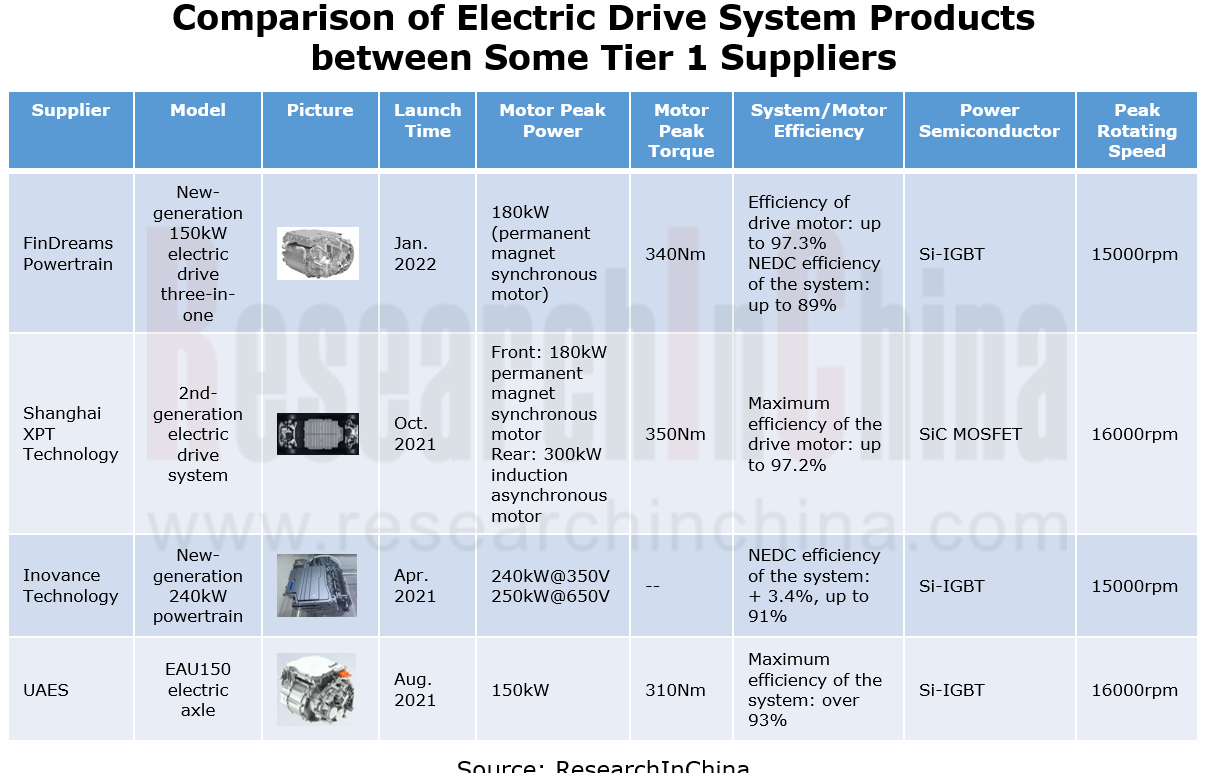
Shanghai Edrive’s GaN “three-in-one” electric powertrain: in November 2021, Shanghai Edrive displayed its GaN three-in-one electric powertrain at Nexperia's booth. The sought-after product boasts much higher efficiency than conventional silicon-based IGBT motor controllers in the same working conditions. The maximum efficiency of GaN-based motor controller reaches 99.34%, and the area with efficiency greater than 90% accounts for 93.58%; that of silicon-based IGBT motor controllers is 98.3%, and the area with efficiency greater than 90% makes up is 83.94%.
Huawei's “X-in-one” electric drive system DriveONE: it integrates seven major components, i.e., BCU (battery control unit), PDU (power drive unit), DCDC (drive power), MCU (microcontroller unit), OBC (on-board charger), motor, and reducer, enabling the deep integration of mechanical and power components. With its superiority in software, Huawei also brings intelligence into its electric drive systems in a bid for integration of terminal-cloud cooperation and control. This X-in-one electric drive system achieves the goal of reducing volume by 20% and the weight by 15%, lowers development cost and realizes matching of vehicle front and rear wheel drives.
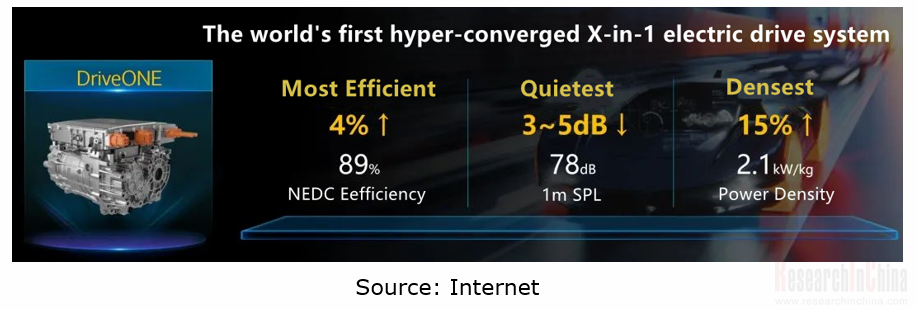
Vitesco Technologies’ fourth-generation electric drive system EMR4: in July 2021, Vitesco Technologies, Continental's former Powertrain Division, unveiled EMR4, its fourth-generation product that offers high power density, compact dimensions, and low weight and covers a power range of 80 kW to 230 kW. Compared with EMR3, EMR4 enables 5% higher efficiency, 30% lower cost and 25% lighter weight, and can carry two high-voltage platforms, 400V and 800V.
Development Trends of Electric Drive System Technology
?“Three-in-one” electric drives keep evolving towards "X-in-one" integrated electric drives.
The conventional "three-in-one" electric drive technology will evolve towards "3+3+X platform", that is, a three-in-one electric drive system (motor, transmission and motor controller) and a three-in-one high-voltage charging and distribution system (DC/DC, OBC and PDU) are combined as a "six-in-one" product, or further integrate with BCU (battery control unit) and VCU (vehicle control unit) among others to constitute a "seven-in-one" or "eight-in-one" product, achieving deep integration of mechanical and power components.
Meanwhile, the electric drive and the vehicle thermal management system are further connected and integrated to form an efficient integrated electric thermal management system. The integration with cooling system composed of motor, electronic control, reducer, DC and power supply, and unified thermal management enable heat source integration, reduce heat exchange and heat loss, and improve heat absorption efficiency of heat pump, so as to extend the cruising range of electric vehicles.
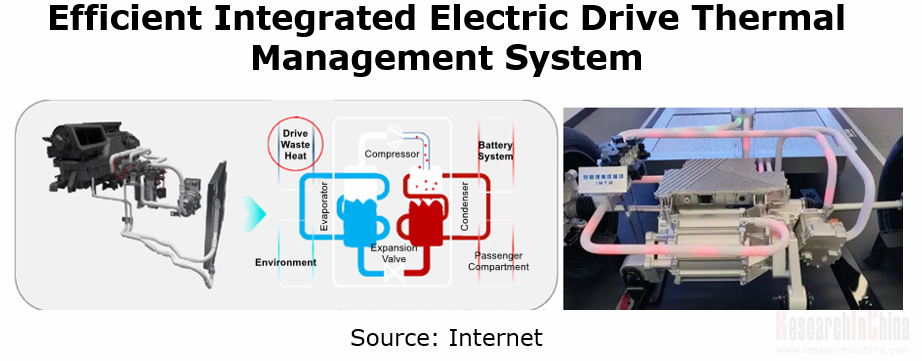
Yet X-in-one systems still face technical challenges (e.g., thermal management, electromagnetic interference and failure rate), and the cost is high. At present, only a few suppliers (Huawei, BYD, etc.) have the systems mass-produced and fit on vehicles. X-in-one systems will still be a R&D priority of OEMs and Tier 1 suppliers in the future.
The penetration rate of flat wire motors surges.
Flat wire motors provide benefits of high power density, low cost, and good temperature performance. Foreign automakers have applied flat wire motor technology early. In 2021, flat wire motors shone in China. Quite a few blockbuster models including Tesla Model 3/Model Y, Volkswagen MEB-based vehicles, NIO ET7, IM L7, ZEEKR 001, and Great Wall ORA Black Cat carried flat wire motors. The overall penetration rate of flat wire motors has approached 20%.
Flat wire motors require high levels of process, manufacturing technology and equipment automation. Chinese suppliers such as Zhejiang Founder Motor, FinDreams Powertrain, HYCET E-Drive and Huayu E-drive have achieved mass production of flat wire motors.
In BYD’s case, compared with previous-generation that uses round wire motors, BYD e3.0 adopts hairpin flat wire permanent magnet synchronous motors with higher copper space factor, lower copper loss, and a power coverage range of 70-270kW. The ultra-thin silicon steel sheet used to inhibit iron loss contributes to a 40% increase in the motor power and the maximum efficiency up to 97.5%. In terms of deceleration mechanism, low-friction bearings and oil guide structure are used to improve lubrication effect and reduce oil churning loss. The fine gear design helps to cut gear sliding loss. Moreover, low-viscosity oil is introduced for the first time, making the transmission efficiency up to 97.6%.
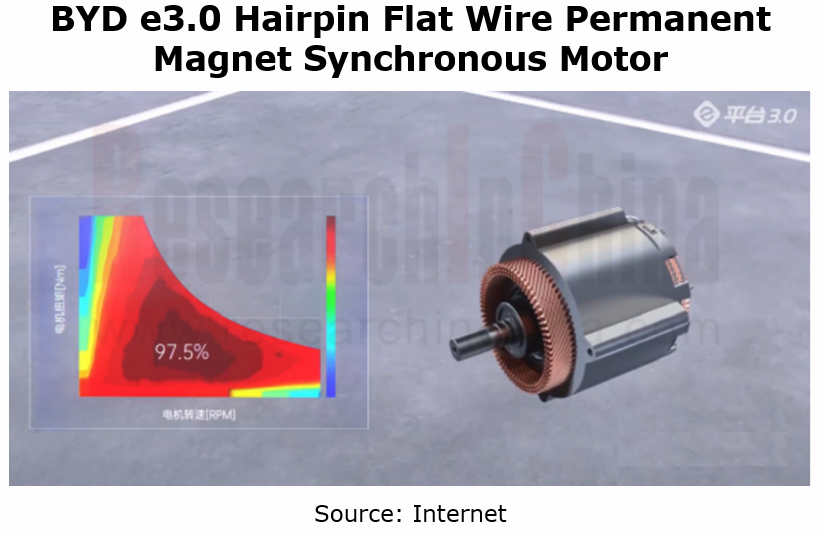
The mass production of 800V SiC high voltage platforms is accelerated.
Chinese automakers race to follow up on 800V high-voltage platform architecture, and achieve mass production and delivery in 2022. Xpeng Motors adopts 800V SiC high-voltage products from Inovance Technology. Xpeng G9 packing XPower 3.0 power system provides two offerings: 2WD single motor (maximum power: 230kW (312HP)) and 4WD dual motor (maximum power: 175kW (238HP) / 230kW (312HP)). The efficiency of the electric drive system can reach as high as over 95%.
Multi-stage gear reducer technology
There is a clear trend of high-speed motors, making reducers head in the direction of two-stage gear deceleration. At present, the motors of Tesla Model 3 deliver rotating speed of up to 17900rpm; most automakers in China have reached 16000rpm and plan 18000-20000rpm. High speed motors however require the support of multi-stage gear reducer technology.
Two-stage gear reducers used in hybrid systems at first are now seen in all-electric systems. Compared with the single-stage gear reducers, two-stage gear reducers allow drive motors to run in a more efficient area, thereby improving the efficiency of the drive system. On the other hand, the use of two-stage gear reducers favors higher gear ratio, better vehicle dynamic properties and shorter 0-100km/h acceleration time.
In addition, the use of two gears makes drive motors more miniaturized and run at lower speeds, thus reducing the cost of motors and ECUs. ZF, GKN, Magna and like have rolled out two-stage gear reducer products.
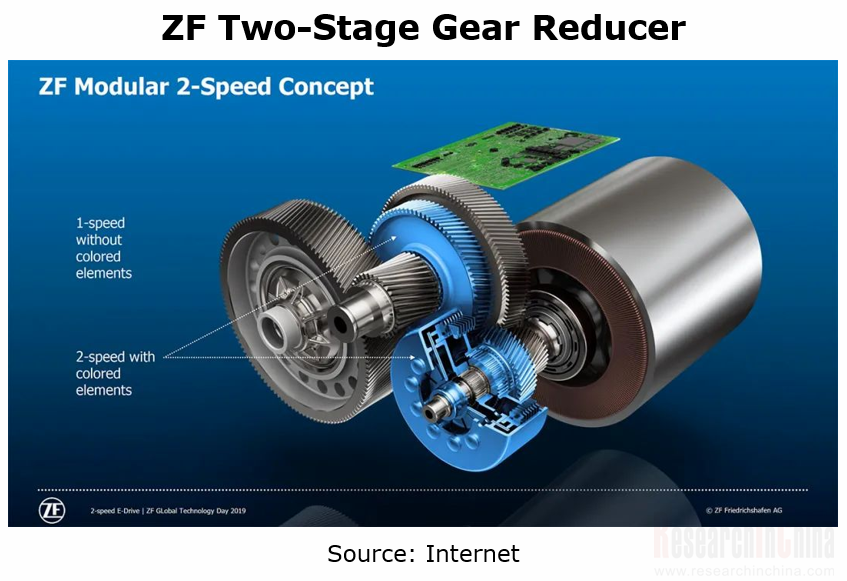
Power domain controllers further evolve towards domain controller centralized and central computing + zonal architectures.
Currently, the three-in-one integrated electric drive has become a mainstream solution in the industry. As "software-defined vehicles" evolve, E/E architectures tend to be domain controller centralized and centralized ones. A number of OEMs and components manufacturers have implemented three-domain architecture, involving: vehicle control domain, intelligent driving domain and intelligent cockpit domain. The vehicle domain controller (VDC) is integrated into the three functional domains: chassis domain, power domain, and body domain.
Independent power domain controller: the power domain combines vehicle controller, motor controller, BMS, on-board charger controller, etc. for example, NETA Auto’s power domain control system (PDCS) integrates software and hardware functions and algorithms of VCU (vehicle control unit) and BMS (battery management system), and uses Infineon multi-core CPU/GPU in hardware architecture. The system provides larger code storage space, greater and securer computing power, and an abundance of input and output communication ports, and supports various forms of composite applications and OTA update capabilities. In the software architecture, the AUTOSAR architecture + MBD modeling application makes software much more reliable and portable.
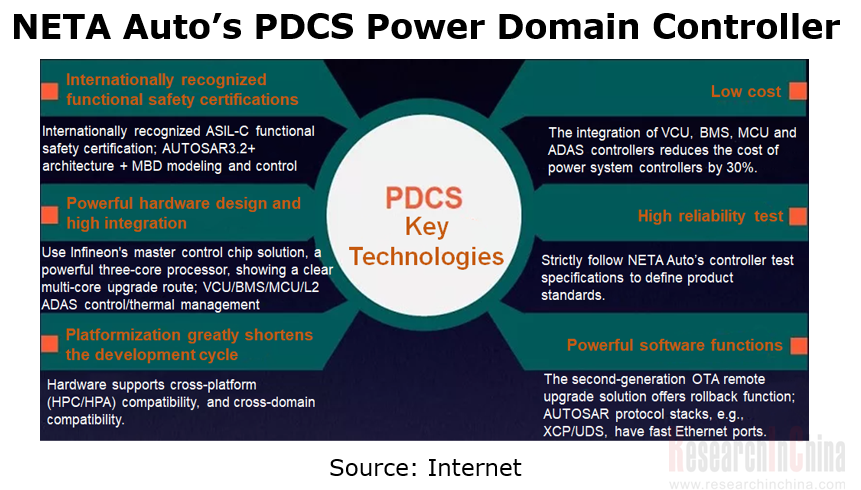
Cross-domain fusion central domain centralized architecture: in Li Auto’s case, LEEA2.0, the domain controller architecture used in Li L9, features three vehicle control domains, of which the central control domain (including power, body and some chassis functions) enables the integration of the body control module (BCM) and the central gateway.
Li L9’s central domain controller uses NXP's latest S32G automotive-grade chip. All of the hardware, systems and software for the controller are self-developed by Li Auto. The functions such as range-extended electric system, air conditioning system, chassis system and seat control system are also independently developed by the automaker, which better ensures the scope and timeliness of OTA updates on Li L9 in the future.
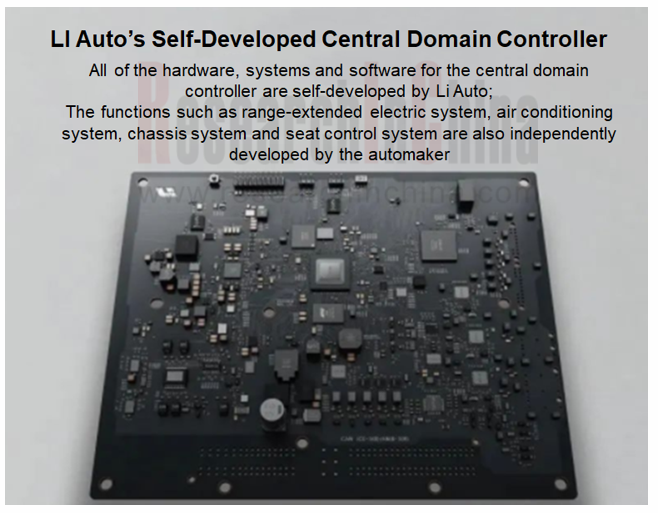
China Passenger Car HUD Industry Chain Development Research Report, 2023
Research on HUD industry chain: new technologies such as LBS and optical waveguide help AR-HUD become a “standard configuration”.
As HUD technology advances, AR-HUD, which can combine virtual informa...
Body (Zone) Domain Controller and Driver IC Industry Research Report,2023
Body (zone) domain controller research: evolution of body electronic and electrical architecture driven by MOSFET and HSD.
The mode of control over body electronic functions is changing with the evol...
China Automotive Fragrance and Air Purification Systems Research Report, 2023
Automotive fragrance and air purification systems: together to create a comfortable and healthy cockpitTechnology trend: intelligence of fragrance system and integration of air purification system
In...
Global and China Solid State Battery Industry Report, 2023
Solid state battery research: semi-solid state battery has come out, is all-solid state battery still far away?In recent years, the new energy vehicle market has been booming, and the penetration of n...
Global and China Passenger Car T-Box Market Report, 2023
T-Box industry research: the market will be worth RMB10 billion and the integration trend is increasingly clear.
ResearchInChina released "Global and China Passenger Car T-Box Market Report, 2023", w...
Analysis Report on Auto Shanghai 2023
Analysis on 75 Trends at Auto Shanghai 2023: Unprecedented Prosperity of Intelligent Cockpits and Intelligent Driving Ecology
After analyzing the intelligent innovation trends at the Auto Shanghai 20...
Chinese Emerging Carmakers’ Telematics System and Entertainment Ecosystem Research Report, 2022-2023
Telematics service research (III): emerging carmakers work on UI design, interaction, and entertainment ecosystem to improve user cockpit experience.
ResearchInChina released Chinese Emerging Carmake...
China Passenger Car Cockpit-Parking Industry Report, 2023
Cockpit-parking integration research: cockpit-parking vs. driving-parking, which one is the optimal solution for cockpit-driving integration?Cockpit-parking vs. driving-parking, which one is the optim...
Automotive Sensor Chip Industry Report, 2023
Sensor chip industry research: driven by the "more weight on perception" route, sensor chips are entering a new stage of rapid iterative evolution.
At the Auto Shanghai 2023, "more weight on percepti...
Automotive Electronics OEM/ODM/EMS Industry Report, 2023
Automotive electronics OEM/ODM/EMS research: amid the disruption in the division of labor mode in the supply chain, which auto parts will be covered by OEM/ODM/EMS mode? Consumer electronic manu...
China Automotive Smart Glass Research Report, 2023
Smart glass research: the automotive smart dimming canopy market valued at RMB127 million in 2022 has a promising future.Smart dimming glass is a new type of special optoelectronic glass formed by com...
Automotive Ultrasonic Radar and OEM Parking Roadmap Development Research Report, 2023
Automotive Ultrasonic Radar Research: as a single vehicle is expected to carry 7 units in 2025, ultrasonic radars will evolve to the second generation.
As a single vehicle is expec...
Autonomous Driving SoC Research Report, 2023
Research on autonomous driving SoC: driving-parking integration boosts the industry, and computing in memory (CIM) and chiplet bring technological disruption.
“Autonomous Driving SoC Research ...
China ADAS Redundant System Strategy Research Report, 2023
Redundant System Research: The Last Line of Safety for Intelligent VehiclesRedundant design refers to a technology adding more than one set of functional channels, components or parts that enable the ...
Intelligent Steering Key Components Report, 2023
Research on intelligent steering key components: four development trends of intelligent steering
The automotive chassis consists of four major systems: transmission system, steering system, driving ...
Automotive Digital Instrument Cluster Operating System Report, 2023
Digital Instrument Cluster Operating System Report: QNX commanded 71% of the Chinese intelligent vehicle cluster operating system market.
Amid the trend for the integration of digital cluster and cen...
800V High Voltage Platform Research Report, 2023
How to realize the commercialization of 800V will play a crucial part in the strategy of OEMs.
As new energy vehicles and battery technology boom, charging and battery swapping in the new energy vehi...
Automotive Intelligent Cockpit Platform Research Report, 2023
Intelligent cockpit platform research: the boundaries between vehicles and PCs are blurring, and there are several feasible paths for cockpit platforms.
Automotive Intelligent Cockpit Platform Resea...